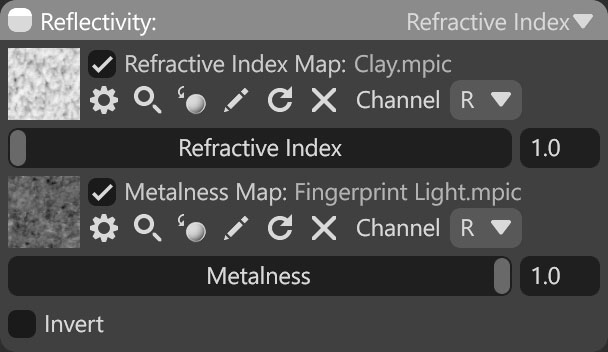Reflective Index defines how much light bends (refracts) as it passes into or out of a material. This affects both transparency and reflection. Materials with higher refractive indices bend light more strongly, creating pronounced distortion and more intense reflections. Common real-world examples include glass, water, and gemstones.
Use cases include:
- Transparent and refractive materials such as glass, water, or crystal.
- Highly reflective materials that combine metallic and refractive properties.
- Stylized materials requiring variable bending or reflection control.
This shading model uses two texture inputs:
- Refractive Index Map (Grayscale): Controls the strength of light bending across the surface. White areas represent stronger refraction, while black areas represent weaker refraction.
- Metalness Map (Grayscale): Defines metallic (white) and non-metallic (black) regions, which influence how reflections behave in combination with refractive effects.
Both maps can be created or sourced in several ways:
- Bake Projects in Toolbag: Generate refractive or metalness data from geometry.
- Toolbag Library: Use pre-made textures.
- Texture Projects in Toolbag: Paint or procedurally generate maps.
- Third-Party Applications: Author maps externally.

| Setting | Description |
|---|---|
| Refractive Index Map Texture Slot | Add a refractive index texture by clicking on the slot or dragging and dropping one from the Library. |
| Channel Selection | Determines which channel of the texture map will be used. It’s useful when, instead of using multiple single textures, you use one texture with different grayscale maps in the different texture channels: Red, Green, Blue, and Alpha. |
| Refractive Index | Sets the index of refraction for this material, which indirectly affects the surface’s reflectivity. Higher values will be more reflective, and will also distort light to a greater degree when used in conjunction with refractive transmission. |
| Metalness Map Texture Slot | Add a metalness texture by clicking on the slot or dragging and dropping one from the Library. |
| Channel Selection | Determines which channel of the texture map will be used. It’s useful when, instead of using multiple single textures, you use one texture with different grayscale maps in the different texture channels: Red, Green, Blue, and Alpha. |
| Metalness Value | Sets the metalness value, which should generally be 0 for insulators or 1 for metals. When a metalness map is loaded, this value should be set to 1. |
| Invert | Inverts the metalness value so that white defines insulators, and black defines metals. |

